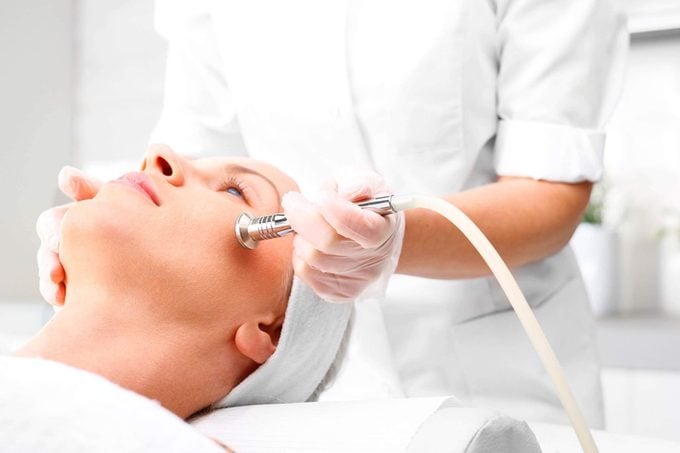Everything You Need to Know About Skin Tightening and the Best Treatments for Saggy Skin
Updated: Feb. 19, 2021
Today, dermatologists and plastic surgeons can tighten lax, sagging skin on the face and body—often without using a scalpel. These are the new treatments that actually work.
What is skin tightening?
Skin tightening refers to a variety of devices, products, and procedures that make the skin tighter, by actually causing some degree of shrinkage and lift, or through creating the appearance of tighter, more youthful-looking skin. However, the term “skin tightening” can be confusing. “Many skin care products, medical devices, and surgical procedures advertise how effective they are in tightening skin, but results can vary dramatically,” says Alexis Parcells, MD, board-certified plastic surgeon and clinical instructor at RWJ Barnabas Health.
Why does skin get loose in the first place?
In a word: Aging. Some sagging and loosening of the skin is a normal part of the aging process, Dr. Parcells says. There are many factors that play a role in the look and feel of your skin as you age. Time, gravity, genetics, exposure to smoke and air pollutants, diet, and radiation from the sun all contribute to your body’s ability to restore or replace damaged skin cells. Additionally, as you age, your body’s supply of collagen, elastin, and hyaluronic acid—the essential building blocks of skin—diminishes. At the same time, your ligaments, which provide the support structure that keeps these building blocks in place, start to weaken, resulting in thinner, saggy looking skin.
“It’s important to understand the aging process and how different our bodies are because this influences what will be effective for you and why your results may differ from someone else’s,” she explains.
Types of skin tightening treatments
There are five basic categories of skin-tightening treatments: Chemical, ultrasound, lasers, radiofrequency, and surgical, says Lisa Cassileth, MD, FACS, plastic and reconstructive surgeon in Beverly Hills, an assistant clinical professor at UCLA, and a previous Clinical Chief of the Division of Plastic Surgery at Cedars-Sinai Medical Center. “It’s wise to consult a dermatologist and a plastic surgeon to understand your options, the overall cost, and to make sure you’re being treated by someone licensed and experienced in those techniques,” she says.
The best skin-tightening treatments
There isn’t one “best” skin-tightening treatment, rather you should be looking for what is the best treatment for your particular skin type and situation, Dr. Parcells says. Another factor is which body part you are looking to improve. The treatments for loose skin on the face are quite different than those for the more delicate skin on your face, she says.
During your initial consultation, you should be very honest about your concerns, motivations for seeking treatment, medical history, and daily habits, she says. “We need all the information to create an individualized plan,” she explains. “Likely this won’t be just one thing but will utilize a variety of products and procedures.”
With that in mind, here are some options to explore.
Chemical treatments
Chemical treatments, such as peels and medicated creams are often the first option many people try as they are widely available and less invasive. “These have been around for many years and can be a great way to tighten skin, reduce lines and impart a slightly lifted effect by improving collagen,” Dr. Cassileth explains. “However, the impact is limited because they can only penetrate superficially.”
There are plenty of OTC topical products that promise to firm and tighten the appearance of neck skin. “Creams, serums, and lotions may contain hyaluronic acid, elastin, or growth factors that can restore a youthful look by temporarily plumping skin after application,” Dr. Parcells says. “For example, hyaluronic acid will bind water to skin cells to moisturize and hydrate—leaving your skin looking smoother and softer.” Just know that these aren’t the same strength you’d get from a doctor and are minimally effective, if at all, she adds.
Radiofrequency microneedling
Radiofrequency microneedling treatments are the hottest new thing, as it allows doctors to target heat to a specific depth and personalize it to the patient, Dr. Cassileth says. “These come in different strengths and powers, from a ‘lunchtime lift’ with a mild freshening effect to a heavy treatment that causes swelling for a week but produces more pronounced results,” she says. “The more powerful treatments are often used by people who have sagging but want to avoid surgery, and a good treatment can take years off your face.”
RF energy heats the collagen under the skin’s surface, causing it to contract as well as to create more collagen naturally, says Hardik Doshi, MD, a facial plastic surgeon at Discreet Plastic Surgery in New York City. “We tighten skin from the inside out and the outside in, sandwiching it between two wands,” he explains. “One wand goes on top of the skin, causing collagen to contract and tighten, and the other goes underneath the skin where it liquefies the fat.” The process is known as radiofrequency-assisted lipolysis.
A tiny puncture in the skin is needed to access the deeper level. Results appear gradually within six weeks to three months, he says. RF treatments can be used on the face and neck or there are types formulated for the body. More than one treatment may be needed if skin is extremely lax.
Microneedling with other technologies
Some newer procedures combine multiple technologies in one device to tighten skin. For example, Vivace is a new treatment that starts with microneedling and adds radiofrequency and laser light. “It is the first device to use a robotic motor to gently push the needles into the skin, allowing smooth, precise control, no downtime, complete comfort, and the optimal delivery system post-treatment,” says Sejal Shah, MD, founder of SmarterSkin Dermatology in New York City. “Both the microneedling and the radiofrequency components stimulate collagen, resulting in skin tightening,” she says. “I use the treatment primarily on the face, neck, and chest but have used it in other areas of the body as well, such as hands, knees, abdomen.” And so far, so good. “Most people have noticed immediately that skin appears more radiant and even tighter. Over time, the skin should appear smoother and firmer, with improved texture and reduced fine lines and wrinkles,” she says. Some people also notice improved tone and more even pigmentation. The number of treatments needed varies but typically ranges from three to six. Here’s why microneedling is such a hot skin-care trend right now.

Ultrasound skin tightening
Ultrasound treatments are newer and are still being refined but show a lot of promise, Dr. Cassileth says. “Ultrasound can pass harmlessly through skin, heating, and tightening deeper tissues. The handheld devices employ sound waves to boost collagen stores under the skin’s surface, firming skin,” she says. “However, we have noticed that this doesn’t work for everyone and sometimes these deep treatments are not enough. They seem to work better for heavy skin with more fat, as it will shrink and tighten up these structures that can cause sagging and jowling.”
Laser skin tightening
Lasers offer a targeted treatment, and lasers that target collagen and water will thicken these structures and reduce fine lines and sun damage, Dr. Cassileth says. These non-surgical procedures are non-invasive, office-based, and have little to no downtime. While these are popular, the lift effect is usually minimal and for best results, you’ll need multiple treatments.
These work better for making your skin look younger by improving skin texture than they do for actually lifting it, Dr. Doshi says.
Surgical skin tightening
Plastic surgery is the gold standard when it comes to skin tightening. “These are always the cornerstone of skin tightening, as there is nothing like removing excess skin to get rid of it,” Dr. Cassileth says. “Surgeons can also target problem areas with different hidden incisions.”
Surgery may also be the only option for people with significant loose skin from childbirth or massive weight loss,” says Mark H. Schwartz, MD, clinical assistant professor of plastic surgery at Weill Cornell Medical College in New York City. “There are always trade-offs. These procedures may have longer recoveries, require general anesthesia, and leave scars, ” he says. “The results, however, are immediate, long-lasting, and can be very dramatic when performed by a board-certified plastic surgeon.” (A word of caution: If you’re considering plastic surgery, you might want to stay off social media when searching for a doctor. Only 18 percent of plastic surgery Instagram posts are by qualified doctors.)
Skin tightening as a side effect
With some procedures, firmer skin is more of a bonus than a goal. The results are not as dramatic as what can be achieved with procedures specifically designed to tighten skin, but for the right person, these benefits may be enough to make a meaningful difference, Dr. Doshi says. Procedures that target fat loss (liposuction, Kybella, Coolsculpting), facial fillers (injectables like Juvaderm, Restalyne), and products for wrinkles (Botox) all provide some degree of skin tightening as a happy side effect, he says.
How to get the most out of skin tightening treatments
What you do in the doctor’s office can only help so much; what you do at home will make all the difference in how well the treatments work and how long the results last. “I tell my patients they need three things: Compliance, a good skin-care routine, and sunscreen,” Dr. Parcells says. Make sure you complete your whole treatment program and follow all your doctor’s directions and then maintain your results with babying your skin and protecting it with a daily 30+ SPF sunscreen.
A word about at-home treatments
There are a lot of creams, serums, and devices marketed for at-home skin tightening. Be very skeptical of these, Dr. Parcells says. “Many simply don’t work and are a waste of time and money. Any devices that are designed to be used at home do not have the same power or energy as the medical-grade devices in the office,” she says.
While it may be possible to get medical-grade chemicals or lasers and use them at home, that doesn’t mean you should, Dr. Cassileth says. She says she’s seen too many DIY treatments result in serious burns and permanent scarring.

